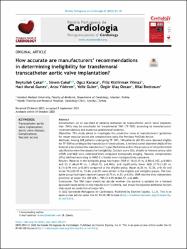How accurate are manufacturers' recommendations in determining ineligibility for transfemoral transcatheter aortic valve implantation?

Göster/
Erişim
info:eu-repo/semantics/openAccessAttribution-NonCommercial-NoDerivatives 4.0 Internationalhttps://creativecommons.org/licenses/by-nc-nd/4.0/Tarih
2023Yazar
Çakal, BeytullahÇakal, Sinem
Karaca, Oğuz
Kızılırmak Yılmaz, Filiz
Güneş, Hacı Murat
Yıldırım, Arzu
Güler, Yeliz
Özcan, Özgür Ulaş
Boztosun, Bilal
Üst veri
Tüm öğe kaydını gösterKünye
Çakal, B., Çakal, S., Karaca, O., Kızılırmak Yılmaz, F., Güneş, H. M., Yıldırım, A. ... Boztosun, B. (2023). How accurate are manufacturers' recommendations in determining ineligibility for transfemoral transcatheter aortic valve implantation? Revista Portuguesa de Cardiologia, 42(1), 31-38. https://doi.org/10.1016/j.repc.2021.09.019Özet
Introduction: Up to one-third of patients indicated for transcatheter aortic valve implantation (TAVI) may be unsuitable for transfemoral TAVI (TF-TAVI) according to manufacturers' recommendations and numerous professional societies.
Objective: This study aimed to investigate the predictive value of manufacturers' guidelines for major vascular access site complications using the Perclose ProGlide device.
Methods: Among 208 patients undergoing TF-TAVI, 144 patients (69.2%) were deemed eligible for TF-TAVI according to the manufacturer's instructions. A minimal lumen diameter (MLD) of the femoral artery below the manufacturer's specified limits and/or the presence of circumferential calcification were the reasons for ineligibility. Calcium score (CS), sheath-to-femoral artery ratio (SFAR) and MLD were estimated from computed tomography imaging. Vascular complications (VCs) (defined according to VARC-2 criteria) were retrospectively compared.
Results: Patients in the ineligible group had higher SFAR (1.13±0.15 vs. 0.88±0.107, p<0.001) and CS (1.66±0.99 vs. 1.24±0.73; p=0.003), and significantly lower MLD (7.72±1.03 vs. 6.31±0.96 mm; p<0.001) compared to the eligible group. Major (6.3% vs. 12.3%, p=0.13) and minor VCs (10.4% vs. 15.6%, p=0.29) were similar in the eligible and ineligible groups. The ineligible group had higher rates of rupture (0.7% vs. 6.3%; p=0.03). SFAR was the only independent predictor of major VCs (OR 469.1, 95% CI 4.95-44466.57, p=0.008).
Conclusion: The TAVI team should not decide whether the patient is suitable for a femoral approach based solely on the manufacturer's criteria, and should incorporate additional factors that could be predictive of major VCs.
WoS Q Kategorisi
Q4Scopus Q Kategorisi
Q3Kaynak
Revista Portuguesa de CardiologiaCilt
42Sayı
1Koleksiyonlar
- Makale Koleksiyonu [3777]
- PubMed İndeksli Yayınlar Koleksiyonu [4230]
- Scopus İndeksli Yayınlar Koleksiyonu [6574]
- WoS İndeksli Yayınlar Koleksiyonu [6631]


















